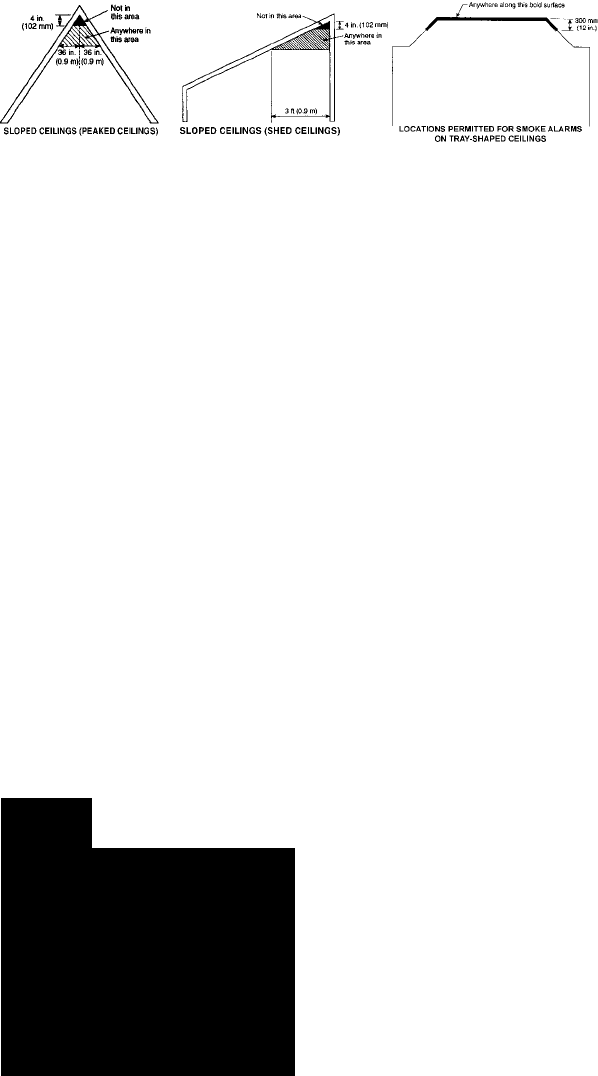
Page 5
Existing Homes:
The NFPA requires a smoke alarm on every level and outside each sleeping area in existing construction. An
existing household with one level and one sleeping area is required to have one smoke alarm.
New Construction Homes and Manufactured Homes:
The NFPA requires AC-powered, interconnected smoke alarms to be installed inside each bedroom, outside each
bedroom area, and on every level of the home. They also require a minimum of two AC-powered, interconnected
smoke alarms in any new construction home.
Sloped Ceilings (Peaked Ceilings):
Smoke alarms or smoke detectors mounted on a peaked ceiling shall be located within 36 in. (914 mm) horizontally
of the peak, but not closer than 4 in. (102 mm) vertically to the peak.
Sloped Ceilings (Shed Ceilings):
Smoke alarms or smoke detectors mounted on a sloped ceiling having a rise greater than 1 ft. in 8 ft. (1 m in 8
m) horizontally shall be located within 36 in. (914 mm) of the high side of the ceiling, but not closer than 4 in. (102
mm) from the adjoining wall surface.
Tray-Shaped Ceilings:
Smoke Alarms or smoke detectors shall be installed on the highest portion of the ceiling or on the sloped portion
of the ceiling within 12 in. (305 mm) vertically down from the highest point.
Mobile Home Installation:
For minimum protection, smoke alarms should be installed in compliance with H.U.D. Manufactured Home
Construction Safety Standards, Title 24 CFR, Section 3280.208 and Section 3282. For additional protection, see
Single Story Residence smoke alarm requirements/recommendations for Existing Homes and New Construction
Homes.
Note: For mobile homes built before 1978, install smoke alarms on inside walls between 4” and 12” from the
ceiling (older mobile homes have little or no insulation in the ceiling). This is especially important if the ceiling
is unusually hot or cold.
Install a smoke alarm inside each bedroom and in the hallway outside each separate sleeping area.
AVOID THESE LOCATIONS
• the garage – products of combustion are present when you start your automobile.
• in areas with high humidity, like bathrooms or areas near dishwashers or washing machines.
Install at least 3 feet (0.9 meters) away from these areas.
• in areas of turbulent air such as air returns or heating and cooling supply vents. Install at least
3 feet (0.9 meters) away from these areas.
• in extremely dusty, dirty or insect-infested areas. Loose particles interfere with smoke alarm
operation.
• in areas where temperature may fall below 40
0
F (4.4
0
C) or rise above 100
0
F (37.8
0
C).
• closer than 5 feet (1.5m) from fluorescent lights, electrical "noise" and flickering may affect
the alarm's operation.
• do not locate this alarm within 5 feet (1.5m) of any cooking appliance.
• in areas of reverse venting of fuel burning appliances caused by outdoor ambient conditions,
such as:
- wind direction and/or velocity, including high gusts of wind. Heavy air in the vent pipes (cold/
humid air with extended periods between cycles).
- negative pressure differential resulting from the use of exhaust fans.
- simultaneous operation of several fuel burning appliances competing for limited internal air.
- vent pipe connections vibrating loose from clothes dryers, furnaces or water heaters.
- obstructions in or unconventional vent pipe designs which can amplify the above situations.
- extended operation of unvented fuel burning devices (range, oven, fireplace, etc.).
- temperature inversions which can trap exhaust gasses near the ground.
- car idling in an open or closed attached garage or near a home.
• to reduce the possibility of nuisance tripping of the alarm’s alarm circuit, accommodation
spaces are to be well ventilated when household cleaning supplies or similar contaminants are
used.











